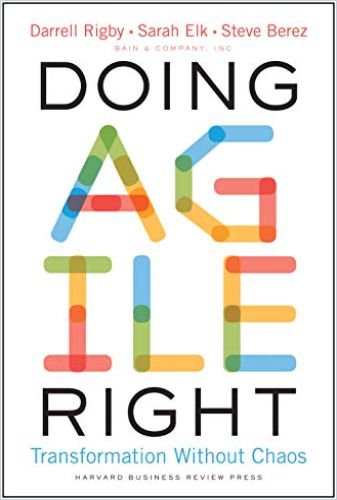A trio of IT consultants explains agile in detail in this worthwhile guidebook for beginners.

Introducing Agile
Bain & Co. consultants Darrell Rigby, Sarah Elk and Steve Berez detail the right and wrong of agile implementation. Exemplars such as Spotify embraced agile to great success. However, the authors stress, poorly conceived agile transitions have led to chaos across companies elsewhere. They set out to save you from such a fate in this smart manual, which made the Forbes list of Top Ten Technology and Ten Mind-Opening Business Books, and was shortlisted for the OWL Awards in Management and Culture.
Agile – the business philosophy that relies on fast-moving, self-managing teams for innovation – has officially entered the mainstream of corporate management.Darrell Rigby, Sarah Elk and Steve Berez
In agile systems, workers experiment freely, and if something doesn’t work, they drop it and move on. This promises large, slow-moving organizations a path to becoming nimble and responsive.It spread from Silicon Valley to, among others, John Deere, USAA, 3M, Bosch, Amazon, Netflix and Spotify.
Continuous Learning
Agile focuses on continuous learning, never-ending adaptation and frontline workers’ empowerment. But some organizations implement agile incorrectly. For example, Sears CEO Edward Lampert claimed job cuts would make the struggling retailer more agile. But Sears’ mass layoffs did not reflect agile management practices. Agile calls for delivering superior results, not explaining away poor performance.
What the agile-everywhere zealots fail to understand is the time-tested virtues of bureaucracy – in some places and contexts.Darrell Rigby, Sarah Elk and Steve Berez
Information technology departments and product developers benefit when freed from command-and-control structures. But some responsibilities – such as food and drug safety, accounting standards, manufacturing regulations, worker safety oversight, aircraft safety and quality control – still belong under top-down management.
Companies that do agile right create productive, self-managing teams that keep their members engaged and happy and accomplish great goals. However, by reducing hierarchy, agile creates fewer opportunities for promotion.
Restructuring Workflows
Saab leveraged agile concepts to create the world’s most cost-efficient fighter jet, the $43 million Gripen. Saab established a group of 100 agile teams that break their tasks down into three-week sprints.
Each morning, teams meet independently for 15 minutes to discuss any challenges. If a team hits an unsolvable problem, it escalates the issue to the 7:45 a.m. meeting of a team of teams. If the challenge remains unsettled, an executive committee weighs the issue at an 8:45 a.m. meeting.
USAA, the financial services company for military personnel and veterans, faces different challenges, but created a contingent of agile, cross-functional teams responsible for specific tasks.
Agile teams work differently from chain-of-command bureaucracies.Darrell Rigby, Sarah Elk and Steve Berez
The timeline for achieving an innovation hinges on the time it takes to complete work and the time it takes to get approvals. Funding schedules and other bureaucratic delays can have an impact. Agile shortens these timelines, in part by moving quickly and removing or reducing roadblocks. Under agile, employees don’t merely take orders. They’re integral participants in the innovation cycle.
Operational Functions
Agile doesn’t mean eliminating all bureaucratic tasks. Operational functions such as payroll and regulatory compliance remain rote, top-down tasks. But companies can benefit from agile in human resources, finance and logistics.
Building an agile enterprise does not mean doing away with bureaucracy completely. Darrell Rigby, Sarah Elk and Steve Berez
You might not divide your regulatory or accounting departments into bottom-up teams, but you must help them understand the new agile management at work elsewhere in the enterprise.
Who Does What
Successful agile adopters assign mundane tasks to agile teams with a taxonomy – a list of every customer-facing detail the company handles.
Often, a taxonomy will reveal that about one-third of current innovation teams are working on things that customers don’t want or teams can’t deliver.Darrell Rigby, Sarah Elk and Steve Berez
Drafting taxonomies can be daunting. A company doing $10 billion in sales, for example, could need 250 to 1,000 teams to handle its myriad responsibilities. Such a number seems dizzying to those who are newcomers to agile. But agile simplifies a complex organization by breaking everything it does into manageable, identifiable tasks.
Ask
To launch agile, leaders should ask: Where can the company free up frontline workers to make their own decisions? How can employees receive more direct customer feedback? Will regular reviews lead to more efficient work? Could a 15-minute meeting every morning identify problems and solutions? And can the company reduce the low-value work it expects people to perform?
If someone has a different solution, ask, “How can we test that?” The authors urge you to emphasize the customer in everything your organization does. Be willing to learn and to acknowledge when facts prove your opinion wrong.
Embrace agile at scale. The further agile spreads throughout your firm, the more managers in bureaucratic departments will learn to adopt rapid decision-making and nimble processes.
Effective agile teams do not blindly follow rules.Darrell Rigby, Sarah Elk and Steve Berez
Grow comfortable with uncertainty. Jack Welch, General Electric’s longtime leader, espoused a top-down approach: He crafted a vision, communicated it and badgered his people to execute it.
An agile mind-set takes quite a different approach to leadership. The agile mind-set embraces uncertainty – the boss doesn’t know exactly where to go or how to get there. Frontline workers figure things out through trial and error. This frightens many executives.
We are perplexed by how many change-management gurus preach, and actually seem to believe, that transitioning to agile approaches must be radical and painful in order to be beneficial. Darrell Rigby, Sarah Elk and Steve Berez
But agile is not threatening. Agile should be fun and should help executives, managers and employees become more creative and productive – and happier. Structure your agile transformation as a series of sprints. Targeting small goals and achieving them quickly inspires and motivates people to pursue more victories.
Perfect Introduction
Rigby, Elk and Berez provide a solid introduction for leaders of companies large and small seeking to implement agile. Because the authors aim for those who are considering beginning agile, their work proves less appropriate for companies who already installed agile procedures or approaches. The authors’ virtues are clarity, structure and completeness. They break down agile in brief, readable sentences and build from one basic concept to the next in logical sequence. They may not be the world’s most exciting writers, but they thoroughly communicate their enthusiasm for agile, the way it works and its results. And, their expertise is unquestionable.
Other works on agile include Coaching Agile Teams by Lyssa Adkins, Learning Agile by Andrew Stellman, Scrum by Jeff Sutherland and The Age of Agile by Stephen Denning.












